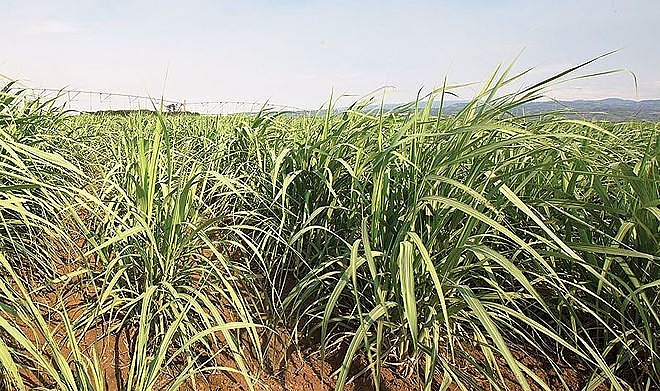Sugar firms anticipated more buoyant upcoming fiscal year
 |
| Positive factors appear promising a more upbeat upcoming fiscal year for sugar firms |
The recently released financial statement of Son La Sugar JSC (SLS) showed that in the fourth quarter of the company’s 2017-2018 fiscal year from July 1, 2017 to June 30, 2018, it fetched VND144 billion ($6.3 million) in revenue, equal to the number recorded one year ago, but its post-tax profits plunged by 39.3 per cent.
For the whole fiscal year 2017-2018, the company’s post-tax profit decreased by 28.9 per cent on-year to VND116 billion ($5.13 million). Lower profits against augmenting asset value have led to a sharp fall in the company’s major profitability indexes.
Accordingly, its return on asset (ROA) ratio fell to 8.2 per cent from 17.8 per cent in the same period last fiscal year, while its return on equity (ROE) ratio dropped to 24.2 per cent from 38.8 per cent.
The SLS results reflect a development shared by most other sugar firms in the 2017-2018 fiscal year.
In the central region, Lam Son Sugar JSC (LSS) even incurred VND11.4 billion ($504,400) in losses in the fourth quarter of the fiscal year, compared to a profit of VND18.2 billion ($805,300) in the same period the year before.
In the whole fiscal year 2017-2018, LSS’ revenue dropped by 39 per cent. As the company produced profits in the first three quarters, LSS still reported VND3.8 billion ($168,100) in full-year profit, a mere 2.8 per cent of the results of the last fiscal year.
In the same vein, Kon Tum Sugar JSC in the Central Highlands region saw its full-year profit fall by 78 per cent on-year to a mere VND9 billion ($398,200) in the 2017-2018 fiscal year.
One of the sector’s best performers, Thanh Thanh Cong Bien Hoa Sugar JSC (SBT), has also suffered falling profits.
In the fiscal year 2017-2018, SBT posted VND10.36 trillion ($458 million) in consolidated revenue, a 2.3-fold increase, and post-tax profits of VND546.7 billion ($24 million), up 61 per cent compared to the previous fiscal year.
This outcome, however, came after it merged with Bien Hoa Sugar JSC (BHS) in October of last year.
In the fiscal year before the merger, SBT and BHS posted VND339 billion ($15 million) and VND289 billion ($12.7 million) in post-tax profit, respectively, reflecting that SBT’s post-tax profit after the merger was still far lower than the combined post-tax profits of SBT and BHS before the merger.
Some new movements in the market, however, support more upbeat growth prospects for sugar firms in the fiscal year ahead.
| A June analytic report by Ho Chi Minh City Securities Corporation forecast an average 4-per-cent growth in sugar demand annually over the next few years to keep up with the rising local consumption. |
In June, the prime minister advocated the Ministry of Industry and Trade’s proposal on the continued application of a tariff quota regime for the sugar sector until the end of 2019.
This means Vietnam will begin implementing its commitments under the ASEAN Trade in Goods Agreement (ATIGA) towards the sugar sector from 2020, paving the way for local sugar companies to become better prepared to meet integration requirements.
As for the sugar price, according to forecasts by Rarobank, a Dutch bank with one-third of products and services serving the agricultural sector, the sugar price in the world market may resume its upward momentum in late 2018 on account of the falling supply and surging demand.
In the domestic market, a June analytic report by Ho Chi Minh City Securities Corporation (HSC) forecast an average 4-per-cent growth in sugar demand annually over the next few years to keep up with the rising local consumption of confectionary (which is expected to grow by 5-6 per cent a year), milk products (10 per cent a year), and soft drinks (7 per cent a year).
This figure almost doubles the world’s average growth.
What the stars mean:
★ Poor ★ ★ Promising ★★★ Good ★★★★ Very good ★★★★★ Exceptional
Related Contents
Latest News
More News
- Businesses ramp up production as year-end orders surge (December 30, 2025 | 10:05)
- Vietjet chairwoman awarded Labour Hero title (December 29, 2025 | 13:06)
- How to unlock ESG value through green innovation (December 29, 2025 | 10:03)
- AI reshapes media and advertising industry (December 29, 2025 | 08:33)
- FPT and GELEX sign deal to develop blockchain tech for global markets (December 29, 2025 | 08:29)
- Vietnam’s GDP forecast to grow by 9 per cent in 2026 (December 29, 2025 | 08:29)
- Women entrepreneurs are key to Vietnam’s economic growth (December 29, 2025 | 08:00)
- Vietnam's top 500 value-creating enterprises announced (December 27, 2025 | 08:00)
- The PAN Group shaping a better future with ESG strategy (December 26, 2025 | 09:00)
- Masan Consumer officially lists on HSX, marking the next phase of value creation (December 25, 2025 | 13:20)

 Tag:
Tag:

























 Mobile Version
Mobile Version